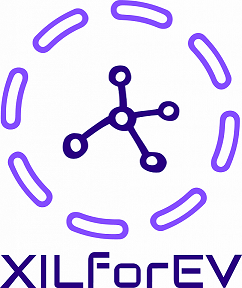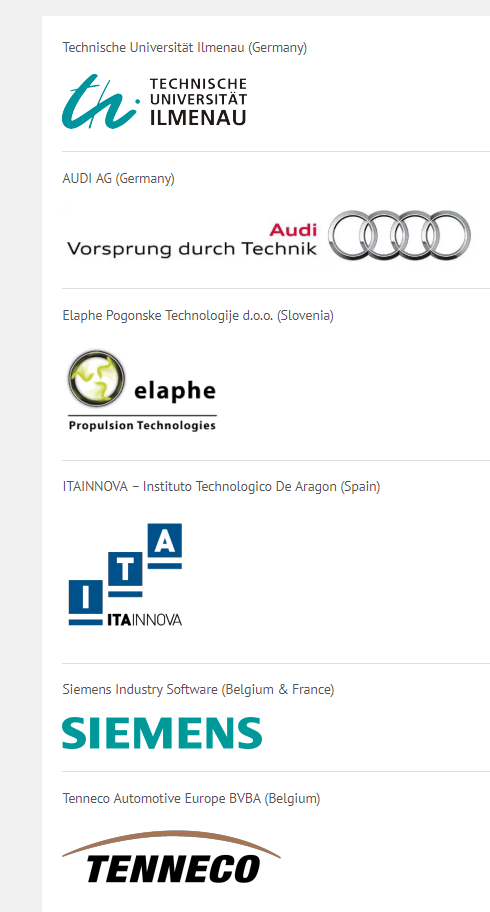Introduce tu búsqueda a continuación y presiona el botón para obtener resultados.
Connected and Shared X-in-the-loop Environment for Electric Vehicles Development

El proyecto propone el desarrollo de una nueva metodología experimental para el diseño de sistemas complejos para vehículos eléctricos. Esta metodología está basada en la conexión en tiempo real de bancos de ensayos y plataformas situadas en diferentes localizaciones geográficas que constituirán un entorno experimental X-in-the-loop (XIL) único. En la ejecución de ensayos se utilizarán gemelos digitales que se actualizan en tiempo real mediante el uso de conceptos de sistemas dinámicos dirigidos por datos (o DDDAS por sus siglas en inglés). Esta nueva metodología de ensayo permitirá explorar interdependencias entre distintos subsistemas que difícilmente podrían ser abordadas hasta los ensayos en vehículo completo.
Topic LC-GV-02-2018 “Virtual product development and production of all types of electrified vehicles and components”
The vehicle electrification is one of the key factors determining trends, challenges and progress in automotive industry for the next decades. Now the growth of new car sales for full electric vehicles (EV) is being forecasted from 2 Mio. in 2020 to 44 Mio. in 2030 (in the aggregate for EU, US and China). Electric vehicles should be cheaper than combustion models already in 2025 . Further increase of the EV role is related to automated driving because an electric powertrain is well-matched with the system architecture of self-driving vehicles by making their control functions more flexible and redundant. These and other factors make the EV segment very attractive for industry. As a result, now not only traditional car manufacturers but also many newborn rivals from the IT sector put a strong focus on the EV development. However, recent observations show that sustainable production of electric vehicles, independently from the model of manufacturing, requires new designing procedures.
Overall development process of electric vehicles consists of many stages, elements and components, which are also being characterized nowadays by unequal levels of technological maturity. In this regard, after analysis of current EV designing technologies, the XILforEV consortium has identified the following specific question, which is insufficiently addressed neither at industrial level nor in research: how to efficiently realize integrated development and testing of EV systems from different domains? The problem is that here not only proper electric powertrain design but also revisiting the automotive chassis design is demanded. The EV motion control requires a blended operation of powertrain and chassis actuators (e.g. brake blending) that motivates at least the following design challenges: (i) harmonization of actuation dynamics of EV powertrain and chassis; (ii) delivering required user acceptance of new EV functionalities; and (iii) addressing more complex requirements to the fault-tolerance and robustness. Under consideration of these factors, the use of well-established processes in the design of EV systems can have some sensible limitations, for instance, co-simulation issues for software-in-the-loop (SIL) / model-in-the-loop (MIL) procedures, availability hardware-in-the-loop (HIL) test setups for different systems at the same host, tangible extension of road trial programmes with added time / cost resources to check new functionalities.
To address this scope of problems, the consortium proposes a new approach aimed at developing a connected and shared X-in-the-loop (XIL) experimental environment uniting test platforms and setups from different physical domains and situated in different locations. The domains under discussion can cover (but are not limited to) hardware-in-the-loop test rigs, dynamometers, software simulators, driving simulators and other variants of experimental infrastructures. Real-time running of specific test scenarios simultaneously on (i) all connected platforms/devices with (ii) the same real-time models of objects and operating environments allows exploring interdependencies between various physical processes that can be hardly identified or even expected on the design development stage. In the long-term perspective, the plug-in concept of including various test platforms/devices and easy on-demand access to the test programmes for developers, engineers and researchers will bring a vast impact to the EV design community through connecting experimental environments around the world.
However, the realization of connected and shared XIL experimental environment is characterized by a number of steps to be solved, e.g. communication concepts ensuring real-time capability of connected experiments, reliable methods for real-time handling of big experimental data et al. With this in mind, a strong consortium has been built, encompassing a wide spectrum of competences, provided by: i) the automotive OEM (AUDI, part of large automotive group) as end-user of the connected and shared XIL technologies on the whole EV level; ii) the manufacturers of vehicle chassis systems (TENNECO) and electric powertrain components (ELAPHE) as end-users of the connected and shared XIL technologies on the EV systems level; iii) the developer of industrial and multi-domain simulation software (SISW); iv) two research institutions with expertise in reduced order modelling, industrial electronics and manufacturing (ITAINNOVA) as well as in automotive engineering and testing technologies (TUIL).
In summary, the XILforEV project brings together seven complementary participants from industry and academia, to address the new design and testing tool for electric vehicles and their systems, based on a sound and objective analysis of the distributed XIL technologies, at a level of depth never attempted by any previous research on the subject. To this purpose the XILforEV activity will include novel techniques for connecting experimental labs and dedicated case studies for designing EV motion control and EV fail-safe control. In addition, considering the importance of virtual models in XIL procedures and the availability of different test benches interconnected, the proposal also addresses the development of high-confidence, real-time capable models with automatic validation using experimental data. In this regard, the project consortium formulated a set of objectives in light of the XILforEV vision and targeted technological challenges. All the objectives listed below address development, design and test procedures as applied to electric vehicles and their systems:
1.Developing the methodology for connected and shared XIL experiments and specifying the architecture of corresponding experimental environment;
2.Designing hardware and software components required for the realization of shared XIL experiments;
3. Introduction of a machine learning layer in XIL subsystem models for automatic improvement of real-time (RT) model accuracy and confidence based on test setup results;
4.Development and validation of high-confidence models suitable for the accelerated time virtual simulation, which will merge the different technologies involved and allow seamless integration and scalability keeping compatibility with Functional Mock-up Interface (FMI) approach to co-simulation;
5. Performing case studies, which will demonstrate practical implementation of the XILforEV concept and the benefits in references cases, incl. validation of fail-safe and robustness functionality of developed systems;
6. Developing procedures for inclusion of users into the shared experiments with consideration of Open Access and Open Science frameworks.
Coordinador: TECHNISCHE UNIVERSITAET ILMENAU
Participantes: AUDI AKTIENGESELLSCHAFT, ELAPHE POGONSKE TEHNOLOGIJE DOO, ITAINNOVA, SIEMENS INDUSTRY SOFTWARE NV, SIEMENS INDUSTRY SOFTWARE SAS, TENNECO AUTOMOTIVE EUROPE BVBA
Horizon 2020 Call: H2020-LC-GV-2018-2019-2020 (Building a low-carbon, climate resilient future: Green Vehicles)
Topic: LC-GV-02-2018 “Virtual product development and production of all types of electrified vehicles and components”
Type of action: RIA
This project has received funding from the [ Horizon 2020 Call: H2020-LC-GV-2018-2019-2020 (Building a low-carbon, climate resilient future: Green Vehicles) [Euratom research and training programme 2014-2018] under grant agreement No 824333

